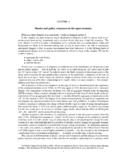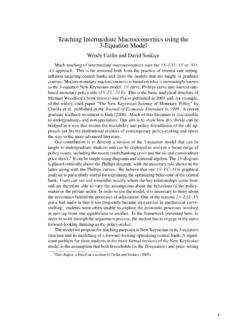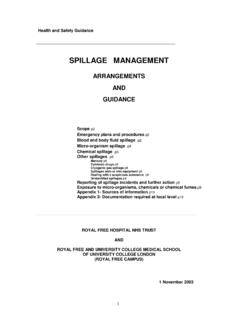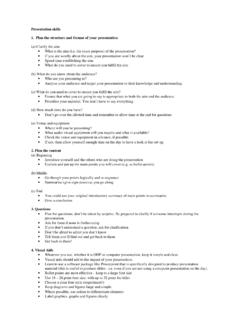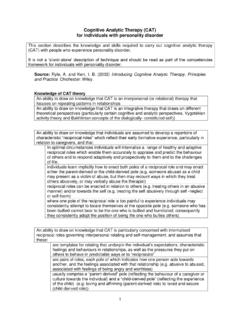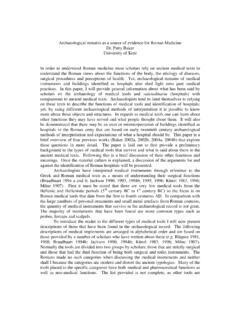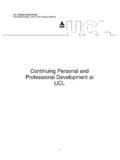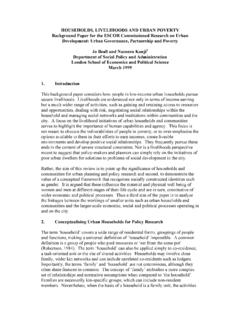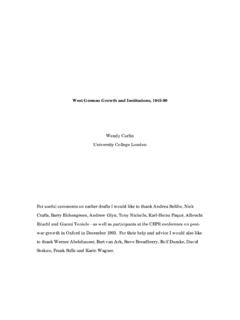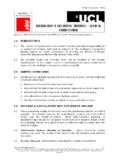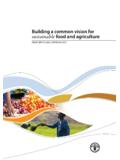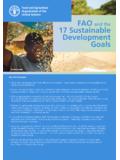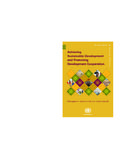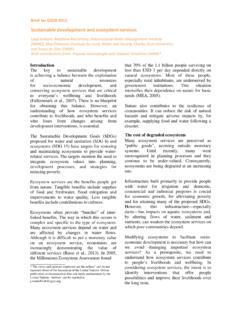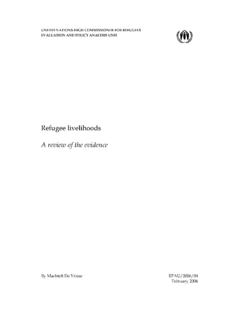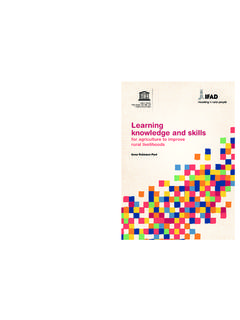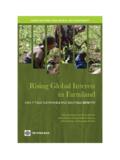Transcription of WP112COV - UCL - London's Global University
1 No. 112 sustainable URBAN livelihoods : CONCEPTS AND IMPLICATIONS FOR POLICY Sheilah Meikle, Tamsin Ramasut & Julian Walker January 2001 Working Paper No. 112 sustainable URBAN livelihoods : CONCEPTS AND IMPLICATIONS FOR POLICY Sheilah Meikle, Tamsin Ramasut & Julian Walker January 2001 Sheilah Meikle 9 Endsleigh Gardens London WC1H 0ED Tel: +44 (0)20 7388 7581 E-mail: Tamsin Ramasut 9 Endsleigh Gardens London WC1H 0ED Tel: +44 (0)20 7388 7581 E-mail: Julian Walker c/o Development Planning Unit 9 Endsleigh Gardens London WC1H 0ED sustainable URBAN livelihoods : CONCEPTS AND IMPLICATIONS FOR POLICY Contents 1 INTRODUCTION 1 2 sustainable livelihoods 1 Characteristics of sustainable livelihoods 1 Core elements of sustainable livelihoods 2 Principles of a sustainable livelihoods approach to poverty eradication 3 The sustainable livelihoods model
2 4 3 URBAN CONTEXT 4 Introduction 4 Social context 5 Economic context 6 Governance 6 Environment and health 7 Urban-rural linkages 7 4 A sustainable URBAN livelihoods MODEL 8 Introduction
3 8 Assets 10 livelihoods strategies 12 Livelihood outcomes 14 Context 14 Men s and women s short and long term objectives 17 Indicators 18 Purpose and nature of sustainable urban livelihood indicators 18 Information gathering for sustainable livelihood indicators 19 Existing evaluation models and indicators 19 5 IMPLICATIONS OF THE sustainable URBAN livelihoods APPROACH FOR POLICY AND OTHER INTERVENTIONS 21 Introduction
4 21 Citizens, not clients 21 Contextual specificity of livelihood tactics 21 Significance of structural constraints 21 Recognition and support of multiple livelihood strategies 22
5 Constraints on livelihoods activities 23 Poverty as a process 23 Points of intervention 23 Types of intervention 23 6 THE WAY FORWARD 24 APPENDIX: Existing sustainable livelihoods models 26 BIBLIOGRAPHY 30 ENDNOTES 34 GLOSSARY OF TERMS 35 FIGURES AND BOXES Figure 1.
6 A sustainable Urban livelihoods model 9 Box 1: Comparison of assets by various authorities 10 Box 2: Assets commonly used by the urban poor 11 Box 3: Some strategies used by poor households 13 Box 4: Vulnerabilities common among the urban poor 16 Box 5: Examples of selected contextual variables 17 Box 6: Nature of selected evaluation methodologies 20 1 sustainable URBAN livelihoods : CONCEPTS AND IMPLICATIONS FOR POLICY 1. INTRODUCTION How poverty is understood determines the way policy makers and planners respond to it.
7 A sustainable livelihoods approach (SLA) adopts a distinctive perspective on the understanding of poverty and how to intervene to improve the conditions of the poor. A sustainable livelihoods approach to poverty eradication is one that acknowledges that poverty is a condition of insecurity rather than only a lack of wealth. Broadly a sustainable livelihood (SL) is a means of living which is resilient to shocks and stresses, and which does not adversely affect the environment. livelihoods compromise(s) the capabilities, assets (including both material and social resources) and activities required for a means of living. A livelihood is sustainable when it can cope with and recover from stresses and shocks and manage to enhance its capabilities and assets both now and in the future, while not undermining the natural resource base (Chambers and Conway, 1992).
8 A range of key features have been ascribed to sustainable livelihoods by a variety of agencies and paper, commissioned by DFID, examines the discussions which range around the concept; considers the implications of the urban setting for this approach; presents a sustainable urban livelihoods model and considers some policy and practical implications of the approach for urban development interventions. Many of the concepts and implications reviewed in this paper are not new to DFID. What is new is the synthesis of a wide range of literature to provide an explicit urban perspective. The sustainable livelihood approach takes as its starting point not deprivation but the wealth of the poor (UNDP, 1998 ).
9 In doing so it builds on the findings of participatory poverty assessments (Booth et al: 1997 cited in Carney, 1998 ) and owes much to Chambers s work on participatory methodologies which, in the main, have been rooted in the rural context (Chambers, 1995; 1997, Chambers and Conway, 1992), as well as to the work of Singh and Titi (1994). Although initially the concept was rural in focus it is becoming increasingly used in both peri-urban and urban contexts (Moser, 1996; 1998, Tacoli, 1998, Rakodi, 1997: Beale and Kanji, 1999). The sustainable livelihood concept has received legitimacy over the last decade through acceptance and development by government and international forums.
10 The 1997 UK Government White Paper on International Development commits the Department for International Development (DFID,1997) to promoting sustainable livelihoods . This objective is expected to contribute to the overall goal of poverty eradication. The Bruntland Commission on Environment and Development, Agenda 21, the Social Summit, the Beijing Conference, Desertification Convention and UNIFEM have all incorporated and further developed the concept (UNDP, 1997). The UN system is currently operationalising this concept (1999). There is a basic similarity in terms of the principles underlying the livelihood approach in rural and urban areas.
